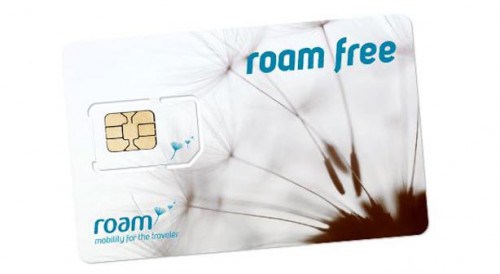 Every year when I head down to the Consumer Electronics Show in Las Vegas, I make a point of field-testing some new gizmos. It’s a great opportunity to try new things out under the stress of battle. With wireless and especially roaming being a hot topic in Canada these days, I decided to go a slightly different direction this time around and try out a service instead this year.
Every year when I head down to the Consumer Electronics Show in Las Vegas, I make a point of field-testing some new gizmos. It’s a great opportunity to try new things out under the stress of battle. With wireless and especially roaming being a hot topic in Canada these days, I decided to go a slightly different direction this time around and try out a service instead this year.
Roam Mobility has been getting some attention of late as a mobile service alternative for travelers to the United States. It’s obvious why, given that the Vancouver-based company is advertising rates that are 90-per-cent lower than the big carriers.
I’ve been testing Roam for the past month, both at CES and during my recent vacation in Texas, and I’m not sure I could more fully endorse it. Simply put, it’s fantastic.
Set-up was easy, provided you have an unlocked phone. The SIM card arrives in the mail and you go online and activate it. You get your own U.S. phone number, then you choose a plan. Here, of course, is where it all matters. Unlimited U.S. and Canada calling and texting plus 300 megabytes of 4G data costs $3.95 a day. In comparison, certain other carriers are charging $7.99 for a measly 50 MB. A 30-day plan with Roam, which nets a whopping nine GB of data, costs $89.95, or infinitely more for considerably less with the other guys.
Roam also has data-only plans, where you can get 300 MB for three days for $7.95. The comparisons to incumbent offerings are, again, decidedly one-sided.
The service itself is pretty good. Roam is using T-Mobile’s network, which is the fastest in the United States, according to that company. Roam doesn’t yet have access to T-Mobile’s super-fast LTE - it says that’s coming soon - but even still, the service isn’t bad, depending on where you are, of course.
In both Austin and Houston, I found speeds to be pretty slow in general, regardless of carrier. Roam came in relatively slow with download speeds generally between two and three megabits per second. But, I also had a second phone with a SIM card from a Canadian incumbent that was roaming on AT&T’s network and the speeds were pretty similar. Texas, it appears, is something of a have-not when it comes to wireless service. Nevertheless, the speeds were still good enough to get emails, tweet and do most of the other stuff I needed to do.
Things were much better in Las Vegas. Roam generally came in around 10 or 11 megabits per second, at least when the phone was away from the network-over-loading crowds of CES. I was quite pleased with this, especially when I discovered that my hotel wi-fi speed measured in the kilobits per second - yes kilobits - meaning that I did quite a bit of tethering to my laptop and iPad.
Putting the speed and price together, Roam’s service had an interesting psychological effect on me. I’ve simply never had the luxury of a whopping nine GB of mobile data before. The more that sank in, the more I let myself go and the more I used my phone. It wasn’t long before I stopped worrying about tethering, because I knew that as long as I didn’t watch Netflix (not that I had time to), I’d probably be okay.
That’s amazing piece of mind - and it only cost a mere $90.
There are cheaper options, of course. Travelers can go right to the source and get a prepaid plan from T-Mobile, for example. The carrier offers unlimited everything at LTE speeds for $70, but there are a few downsides for Canadians. The biggest is that you have to find a T-Mobile store wherever it is that you’re going, which is not always easy. The second is that your account gets suspended if it’s inactive for more than 90 days. That’s not a problem for frequent U.S. travelers, but those people who go down once in a while will have to go through the whole rigamarole all over again. Roam’s $20 premium therefore isn’t much of an outlay in exchange for the hassle savings.
In my next post, we’ll talk to Roam Mobility chief executive Emir Aboulhosn on the company’s future and where the roaming market is going.

Ry
January 17, 2014 at 10:22 am
I am using a T-Mobile prepaid account, and love how convenient it is. I don’t get call back to Canada, like Roam does, but I filled that need with Google Voice (for now). I started this back in 2009, prior to Roam launched. One thing to mention is, if you accumulate 100 (over any period of time, as long as the account did not expire), you get 1 year expiry going forward. I ended up putting 100 back in 2009, and then small 10 dollar top ups once a year to keep it going.
Other thing I do is put my Canadian sim in an old Android phone with Tasker and leave it on my desk at home. It will email me any sms and voicemails that come in, while I’m down in the USA. Only downside is any layovers in Canadian Airports, I don’t really have access to a phone.
Joan McArthur
January 19, 2014 at 8:55 pm
I’ve been happily using Roam for a year or so. It’s so nice to travel without that niggling worry about roaming fees. All my experiences with Roam has been first-class…I hope everybody finds out about this great alternative to big telecom - at least when they cross the border.
Thanks for the write-up, they deserve all the publicity they can get.